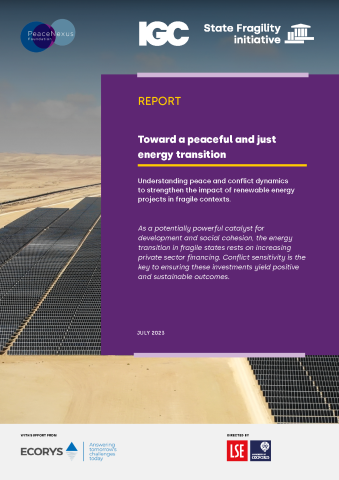-
Towards a peaceful energy transition July 2023
PDF document • 4.93 MB
This paper is intended to be of value to public and private investors (‘investors’) and entities involved in development, construction, and operations of renewable energy projects (‘project developers’) in fragile and conflict-affected situations.
For any inquiries about this work or further engagement, please contact the IGC’s State Fragility initiative team at [email protected] or PeaceNexus at [email protected].
Executive summary
Achieving targets for universal energy access and net zero emissions by 2050 requires an exponential expansion of investment in renewable energy, including in fragile and conflict-affected settings (FCAS). These countries are home to many of the 675 million people living without access to electricity globally. Renewable energy (RE) projects in FCAS have delivered positive socio-economic impacts to local communities and, in some instances, enhanced social cohesion. However, if not implemented with sufficient conflict sensitivity, there is a risk that RE projects in FCAS have unintended negative impacts, including reinforcing existing inequalities, violating human rights, exacerbating community grievances, and worsening local conflict dynamics.
As we look to scale up RE projects in FCAS, it is essential that project developers and investors design and develop RE projects taking into account the varying local contexts where these projects will be developed to avoid triggering unintended negative impacts.
Improved conflict sensitivity and contextual awareness in FCAS benefits project developers and investors, as well as local communities, by helping to better mitigate and manage risks that come with operating in fragile settings, thereby minimising the likelihood of unrest, costly project delays, disruptions and damage to infrastructure. Beyond their benefits to both business and society, responsible business practices are increasingly mandatory: as growing demands for greater responsiveness to environmental, social, and governance (ESG) concerns translate into expanded regulatory frameworks, conflict sensitivity is vital for investors and project developers to meet heightened due diligence and reporting requirements for their activities in FCAS.
Drawing on literature and interviews with project developers, investors, affected communities, energy practitioners, and researchers, this paper offers five key recommendations:
- Integrate conflict sensitivity throughout the lifecycle of the RE project. By strengthening understanding of the mutual interaction between the project and context, conflict sensitivity helps to manage risks, maximise the positive impacts of RE projects, and support more informed decision-making. It is a continuous, tailored approach that brings greatest benefit when integrated throughout the project lifecycle. Key elements include:
• Undertake a conflict assessment – A robust conflict assessment is the foundation of any sound due diligence and risk management framework in FCAS. If done well, it provides a thorough insight into the interactions between the project and local context. Although the components vary based on a given context, a conflict assessment typically includes context analysis, stakeholder mapping, conflict risk screening, and the identification of key trends as well as opportunities for positive impact. Findings should be integrated into the project design and business processes.
• Develop a comprehensive risk mitigation and management framework – This framework should be based on findings from the conflict assessment and community engagement and identify measures to address risks to the project and local context.
• The continuous analysis of the interaction between the project and local context enhances understanding and foresight and facilitates effective risk mitigation throughout the project’s lifecycle. The framework should be regularly refreshed based on changes in the context.
- Engage continuously and meaningfully with affected communities. This is vital for generating public and political acceptance of the project and understanding the perspectives of those affected by it. Establishing and cultivating meaningful, systematic engagement necessitates accessible and responsive communication channels, which can build trust and deepen understanding of community dynamics. Key components include obtaining informed consent; identifying opportunities to leverage and develop local capacity (such as workshops and training programmes); establishing accessible grievance mechanisms; adopting a systemic approach to information sharing; and employing effective communication strategies that convey information about the project, opportunities, benefits, and potential impacts.
- Ensure the benefits communities experience from the project outweigh any harms caused. Furthermore, to go beyond ‘doing no harm’ to create positive peace impacts, projects should be intentionally designed and developed with this aim in mind and should seek to address existing conflict drivers among affected communities. Attention should be paid to the equal distribution of benefits across different interest groups. This may require the provision of skills training (by either government or project developers) to ensure that some local community members are able to be employed on the project. Opportunities can also be created by the RE supply chain and productive use of the generated energy (either from the project or separately installed. Such opportunities should also be explored with local community members in community consultations. Local community expectations should be managed where necessary, to ensure that unrealistic expectations do not later give rise to anger and resentment.
- Explore opportunities to increase the flexibility, duration, and risk tolerance of capital provided. Blended financing solutions that include grants or concessional loans can make projects more financially attractive for a wider range of investors with different risk-return profiles and can support affected communities by reducing the cost of energy. Both increasing equity participation and local currency financing can reduce the debt servicing burden in the initial phases of the projects, giving project developers more flexibility to accommodate the needs of local stakeholders. Furthermore, investors should explore possibilities for investing in local intermediaries (banks and investment funds) that have greater contextual knowledge and can support smaller RE project in fragile states. Critically, investors and donors could play a pivotal role in mainstreaming conflict sensitivity by requiring it as a condition of funding RE projects in FCAS.
- Share learnings from developing RE projects in FCAS. The sharing of information among project developers and investors on project design, community engagement, and associated impacts is essential to improving practice. Sharing experiences of risks faced and of integrating conflict sensitive approaches into RE project development is crucial to encourage other private sector actors to follow suit by demonstrating the value of conflict sensitivity, as well as to increase market information that can lead to more accurate risk expectations (and potentially reduced risk premia). More external evaluations of the impacts of RE projects in FCAS will strengthen the evidence base on what works to minimise negative impacts and maximise positive impacts of these projects.
RE can increase energy access to millions of unconnected people in FCAS, enabling increased incomes, better access to education, healthcare, and other basic services. When designed and implemented in a conflict sensitive way, these projects may also contribute to peace and stability in some of the world’s most challenging contexts.





